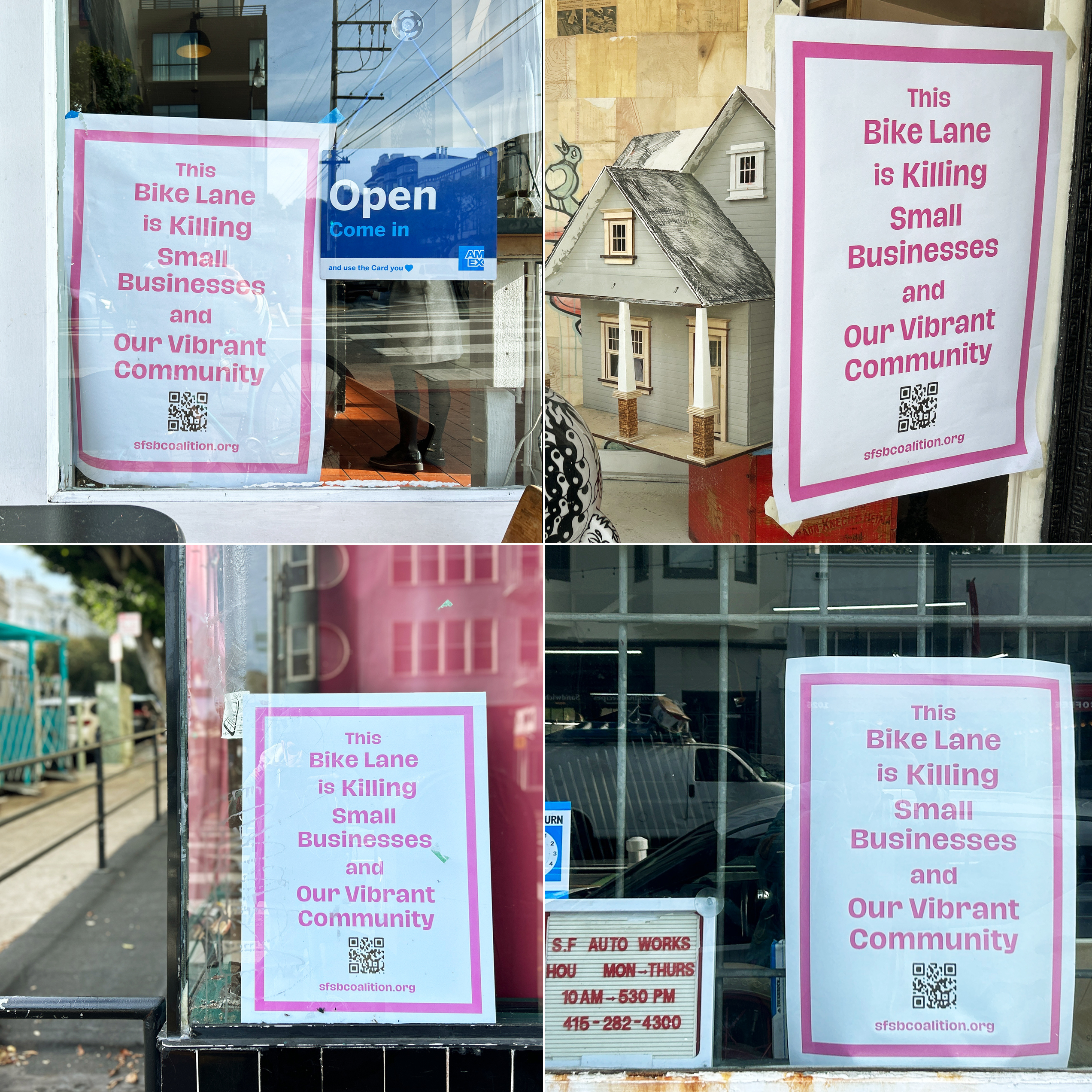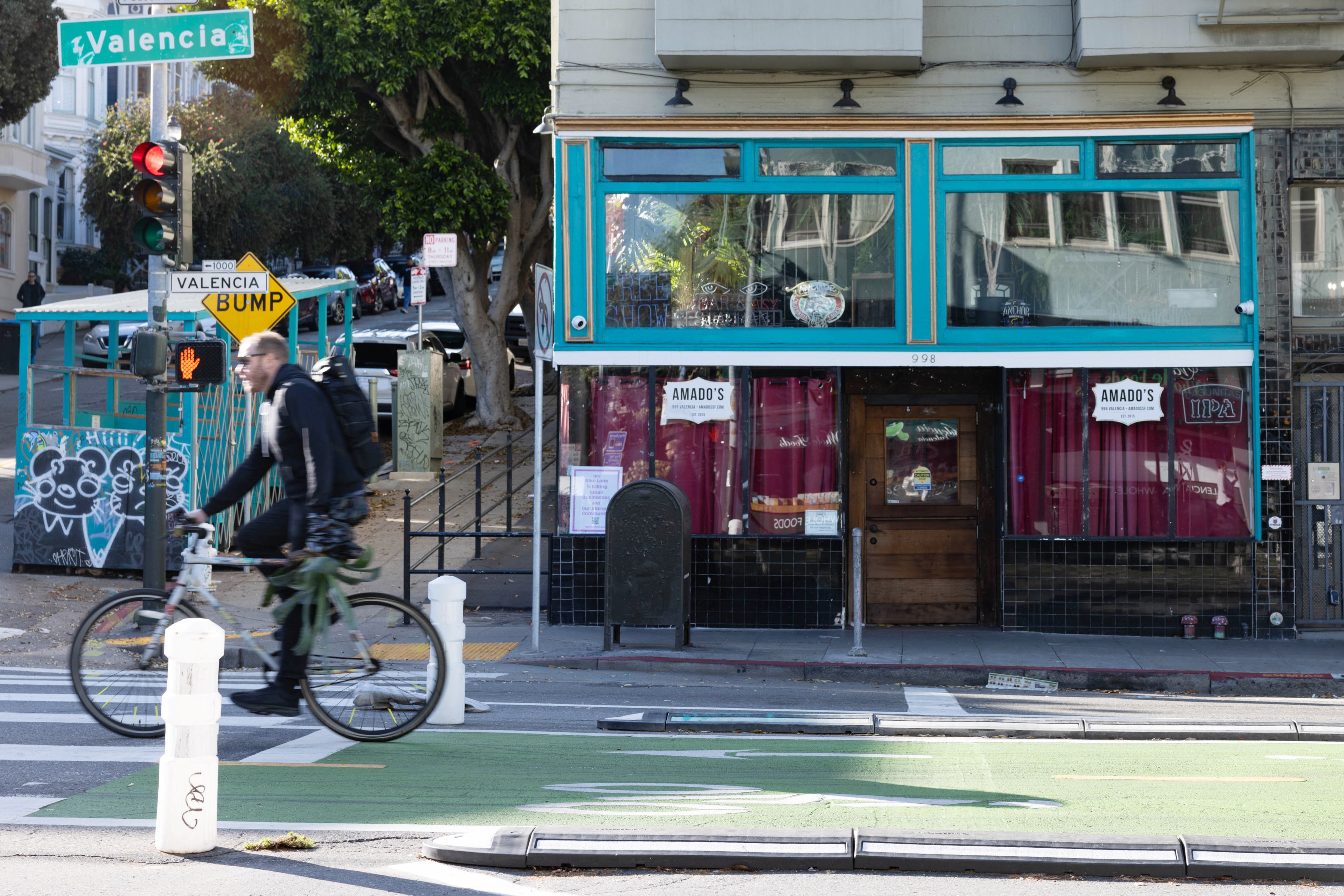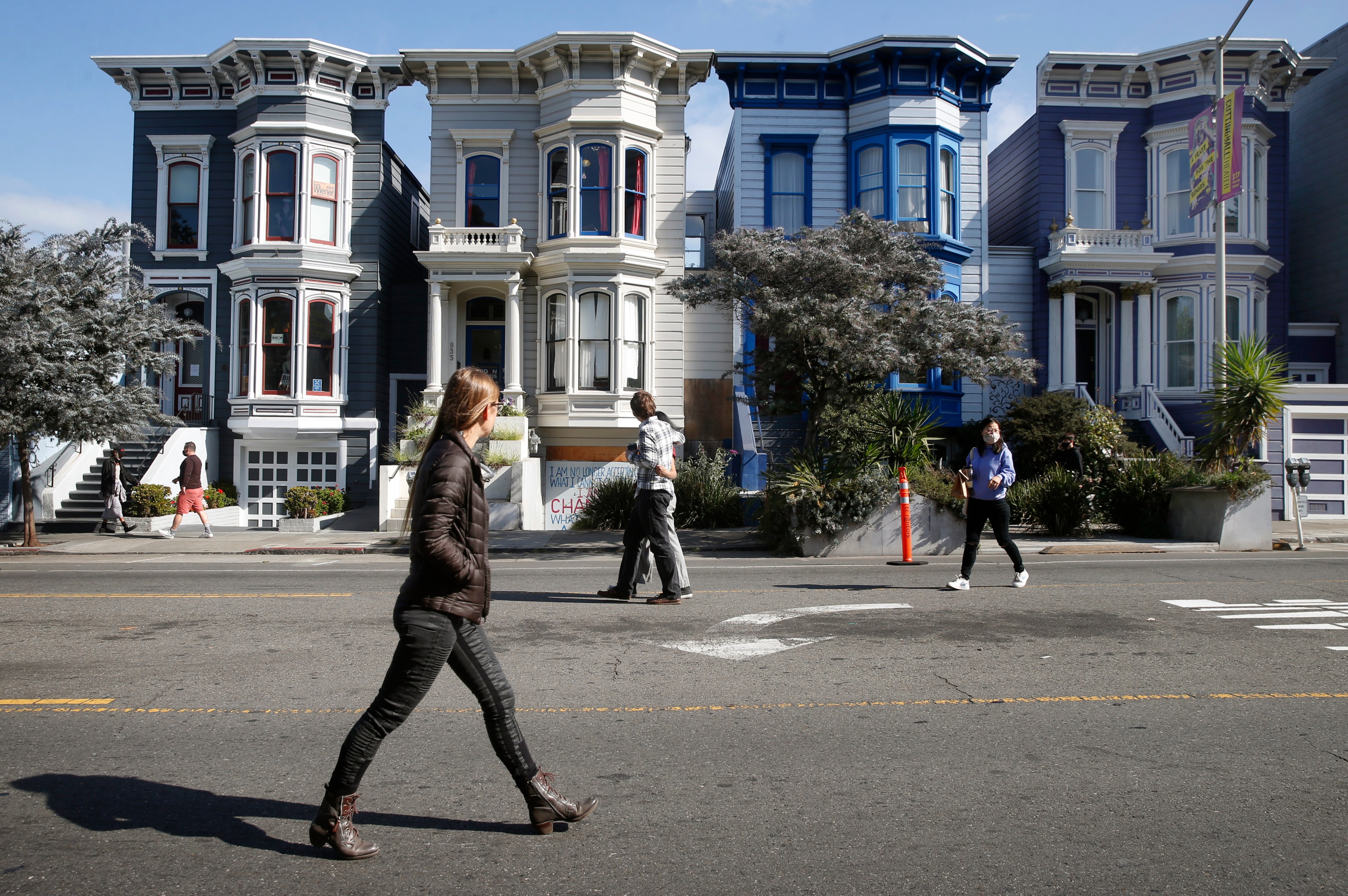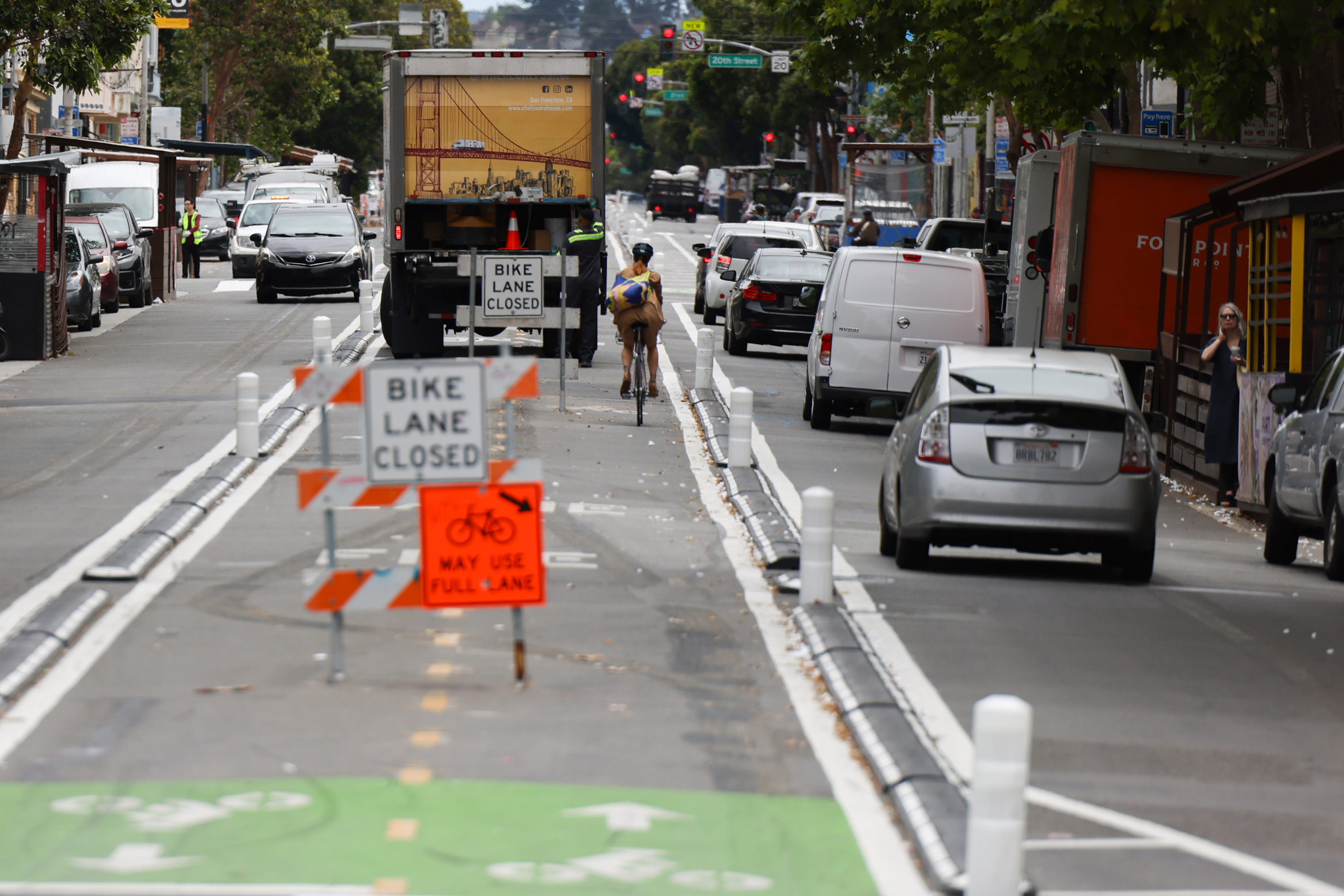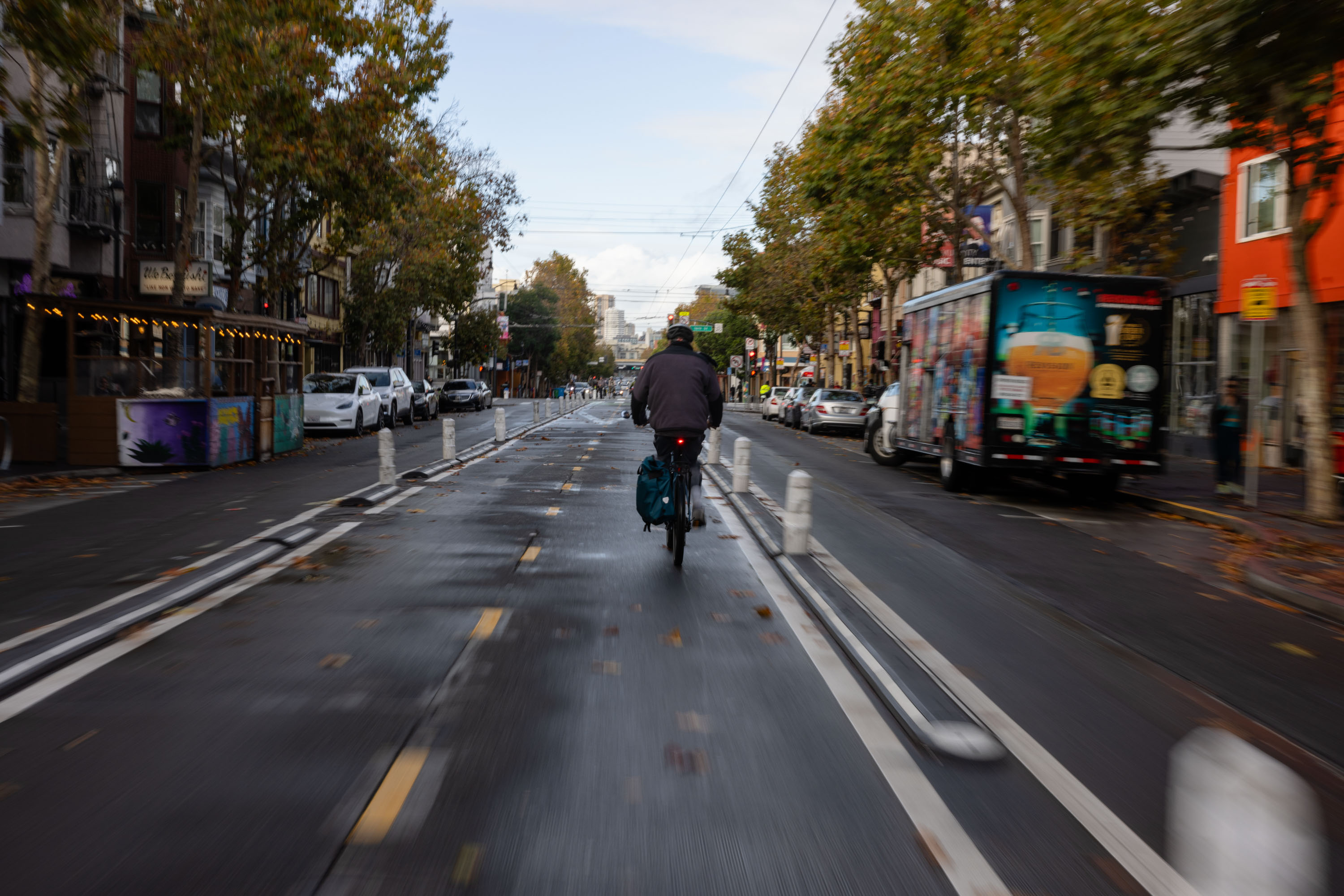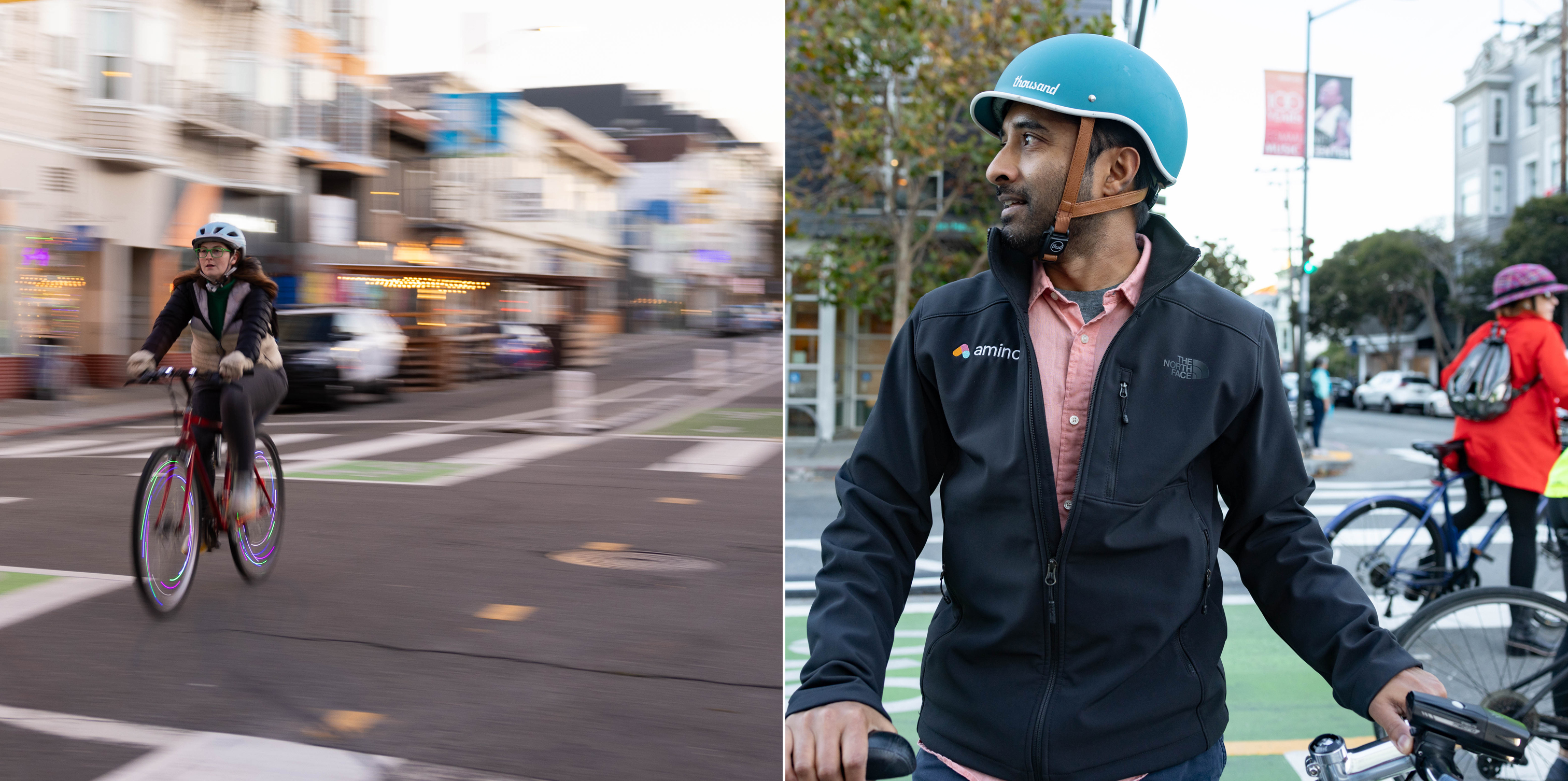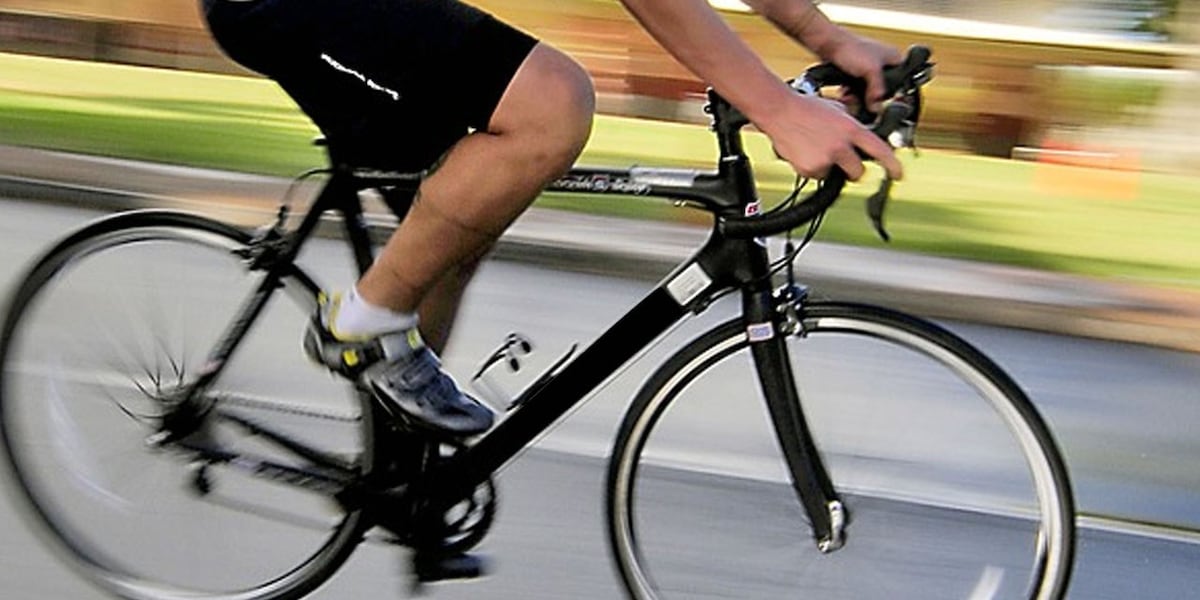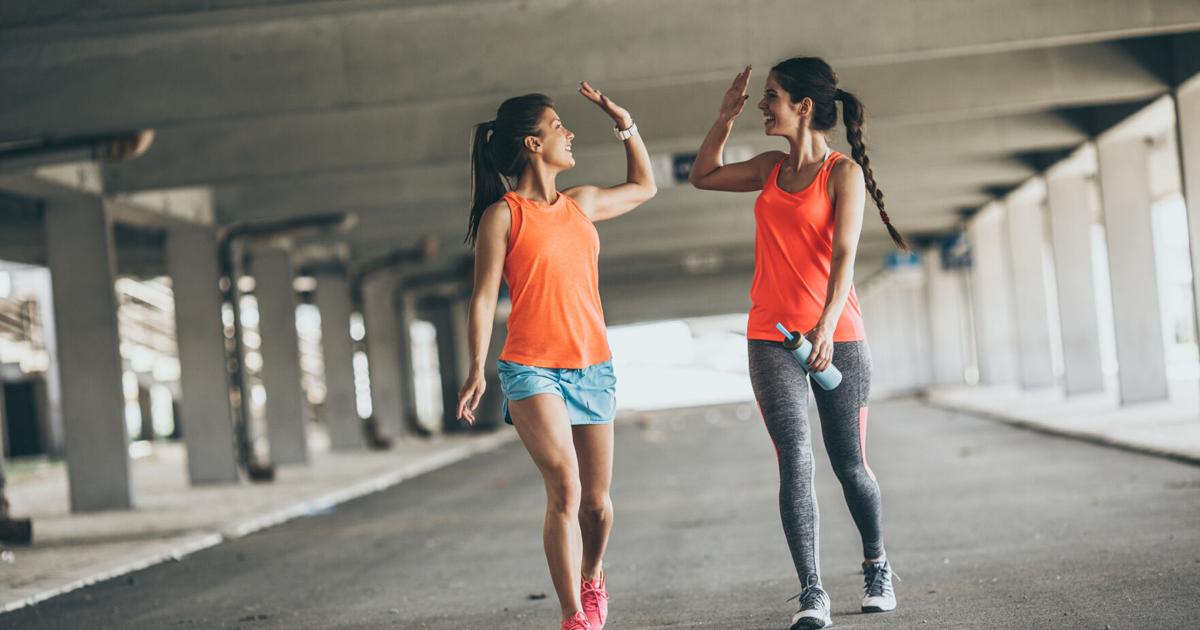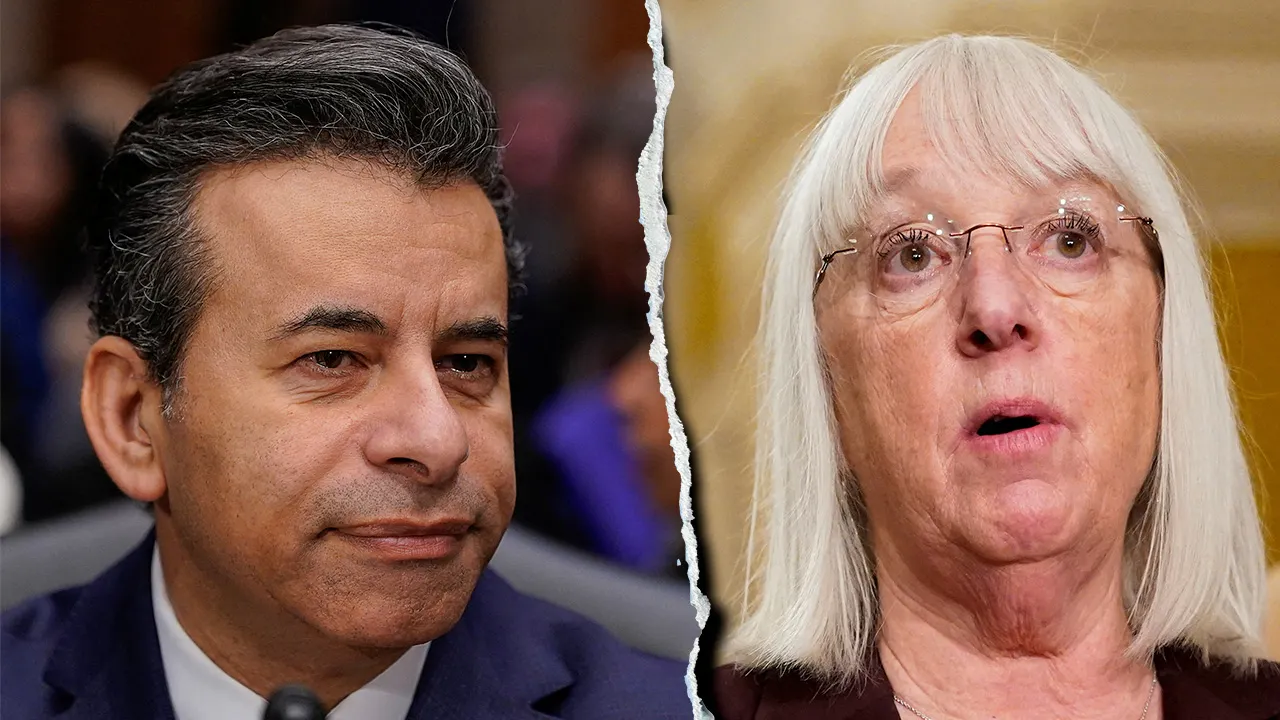Two of the most heavily used bike lanes in San Francisco intersect in the city’s Mission District, at Valencia and 17th streets, where there’s a taqueria, a police station, an upscale furniture store and a famous sex shop.
San Francisco, CA
After a Bike Lane Moved, This SF Neighborhood Erupted
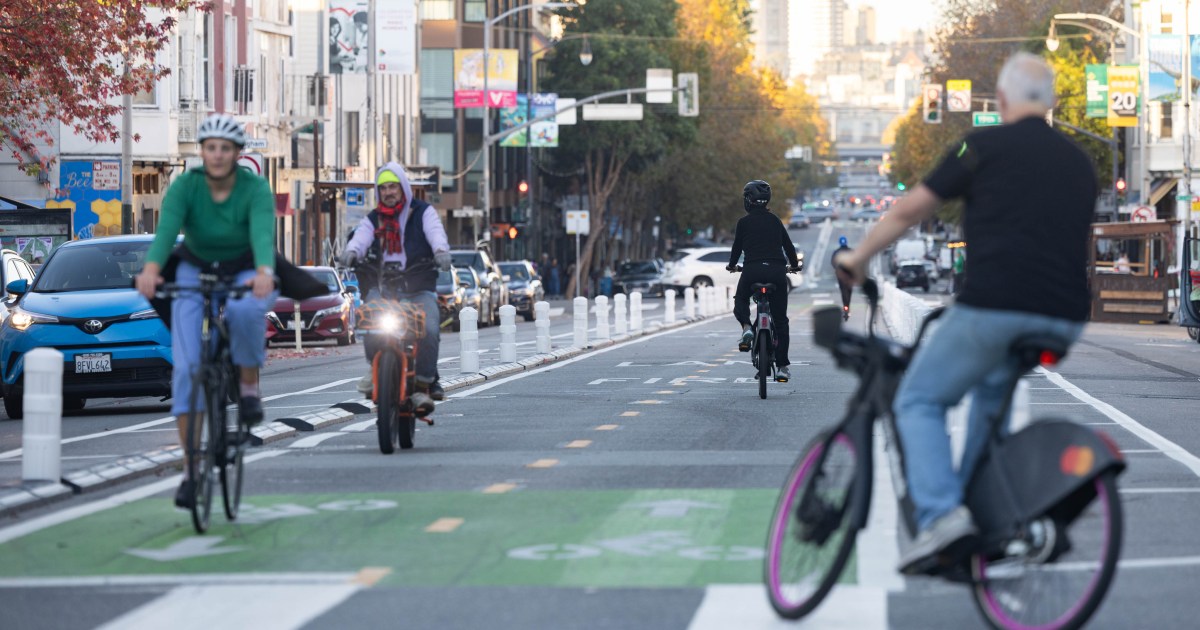
One set of lanes cuts east-west, from the giant rainbow flag in the nearby Castro across the Mission into Potrero Hill. As with most bike lanes, these flank the parking lane, are generally unprotected from cars and, for the most part, don’t offend anyone. The other, running north-south through the ever-trendy neighborhood, has lately become a cultural flashpoint, a fight on par with the conflict over tech shuttle buses.
Four months ago, the San Francisco Municipal Transportation Agency relocated the north-south bike lanes along Valencia between 15th to 23rd streets from the sides of the street to the center, zipping them together for the span of eight blocks before unzipping them again. In the process, several dozen parking spaces were eliminated, too.
On that section of road, plastic bollards and firm barriers separate cyclists from vehicular traffic, with a buffer zone on either side. In itself, this “cycle track” configuration might be little more than a procedural tweak by a city that’s always tinkering with its streetscape, from lane-narrowing “road diets” to mileslong rapid transit projects for buses.
But something about this change in this place just hits different, as they say, perhaps owing to its perpetual popularity as a destination and its convenience as a through route. Here, solo drivers, Ubers, Lyfts, robotaxis, cyclists and delivery vehicles are ceaselessly jockeying for asphalt across Valencia’s 82 feet, 6 inches of width.
Grumbling about this eight-block stretch has been building since summer. But the anger erupted Tuesday when several dozen small business owners occupied the street, chanting and holding signs calling on the city to remove the lanes, as Streetsblog first reported.
The protest came just a few days after the bar and live-music venue Amado’s closed, with its owner claiming that sales dropped 80% after the bike lane was installed and created a hassle for musicians due to a lack of parking.
Opponents have seized on the bike lane as more evidence that the city runs roughshod over the small businesses that fill its coffers with tax revenue and give it character. But how does moving a bike lane by a few feet destroy a business?
More Than Just a Bike Lane
Walk down Valencia, and it’s impossible to miss the pink-and-white signs in the windows of many shops that read, “This Bike Lane Is Killing Small Businesses and Our Vibrant Community.”
Yasmin, a Middle Eastern restaurant that already endured arson and a legal imbroglio with its landlord, has one. So do two auto shops, businesses with something of a direct interest in car culture. Ditto for Curio and Amado’s, restaurants and live-music venues that serve alcohol.
“Everybody’s focused on the bike lane, but it’s really about a bureaucracy,” said Bill Dickenson, who sits on a steering committee of the San Francisco Small Business Coalition, which organized Tuesday’s protest on Valencia. “The SFMTA is a government agency that has gone rogue in many ways.”
In Dickenson’s view, the powers that be have pit cyclists against small businesses unnecessarily, and it’s a canard that the center-running bike lanes are part of a flexible pilot program that can be tweaked based on public input, which is the city’s current position. The transit agency giveth, and the transit agency will never, ever taketh away.
“It’s not a pilot!” he told The Standard. “There were millions and millions in there, and the [San Francisco] Bike Coalition kept pushing for more infrastructure. This is a misuse of public funds. A ‘quick-build’ would be chalk and paint.”
An April 2023 planning document appears to put the cost at $590,000, funded by several previous ballot measures, but SFMTA confirmed to The Standard that $1.5 million had been spent so far, with the total amount yet to be determined.
From the perspective of Valencia merchants, the past three years have been an unending nightmare of public-health restrictions, rising costs and a likely permanent reduction in people eating out. Now the same city government whose transit agency radically altered Van Ness Avenue to the consternation of merchants there and whose Department of Public Works has a multiyear corruption scandal has rammed through a project nobody seems to want.
Asked if he and other small-business owners would prefer the previous bike lanes or no lanes at all, Dickenson demurred. But he claimed many people are unhappy with the current configuration, like senior citizens now forced to circle the block while trying to find parking near the corner grocery store. Or residents who live just off Valencia and are finding more cars parked on their streets these days.
When pressed, Dickenson said he merely wants something that’s better-designed. Ticking off features, he described something much like Valencia’s previous iteration.
“Something with two directions on either side that allows public-safety first responders to move the way they used to, that allows cars to pull out,” he said. “Why did they put the curbs in there? A sixth-grader can look at this and say this doesn’t work.”
Voicing a fairly widespread belief, Dickerson said he believes ride-share companies like Uber paid the city to remove parking spaces to free up room for pickups and dropoffs.
Reached for comment, a spokesperson for Uber told The Standard, “The SFMTA regularly reaches out about issues impacting safety and efficiency around the city. We did not discuss the removal of parking spaces.”
For its part, the transit agency says it’s heard business owners’ concerns and has restored some of the 70 parking spaces that were removed.
“We temporarily adjusted the type and duration of many of the loading zones on Valencia Street between 15th and 23rd streets and on several side streets (18th, 19th, 20th, 22nd) to create more general parking availability in the neighborhood,” SFMTA spokesperson Stephen Chun told The Standard in a statement.
From October until this month, Dickenson was the interim operations director of Amado’s, the now-closed bar. But the bike lanes weren’t the only challenge for that longtime home for underground music and performance this year. In June, Amado’s suffered a flood, resulting in $500,000 in damages. A crowdfunding campaign that aimed to raise $50,000 toward repairs has garnered just half that.
Asked how many Amado’s patrons drove to a venue with, at most, a handful of parking spaces on the block, Dickenson responded with statistics about an unspecified competitor’s bottom line in the period during and after Covid.
“We reached out to a number of businesses and—I won’t name them—but one well-known business owner has a restaurant on Valencia and a restaurant somewhere else in the city,” he said. “The other place saw a 3% dip, and Valencia saw a 50% reduction when the bike lane went in.”
Already a Compromise
Despite the business owners’ complaints, study after study shows that bike lanes typically yield positive economic outcomes for businesses along their corridors.
During Covid, when Valencia Street was temporarily pedestrianized, Yelp’s data concurred. But the idea that bike lanes are bad for business has entered the cultural bloodstream, seemingly as axiomatic as the erroneous belief that homeless San Franciscans mostly come from somewhere else.
The transit agency could strengthen its case by releasing promised metrics on the Valencia Street pilot project, but Chun said that it’s going to be a while.
“The data-gathering started later than anticipated,” he said.
This opacity is clearly infuriating to small-business owners. But it is also a challenge for advocates who want to know if cyclists are using the street less or if drivers are zooming through intersections.
“It’s incredibly frustrating that the SFMTA hasn’t given us the evaluation data they promised us at quarterly milestones,” said Claire Amable, a Tenderloin native and the director of advocacy for the San Francisco Bicycle Coalition. “We’re four months in, and we were supposed to get it at three, six and nine months.”
The bicycle coalition hears feedback from its members, who seem to be evenly divided on the current state of Valencia, and the organization has offered suggestions for improvement while allowing the fire department to maintain emergency access. Amable says bike lanes are most successful when everyone embraces them but notes that the existing configuration on Valencia was the product of a protracted back-and-forth.
“This design was already a compromise based on merchant feedback from 2020,” Amable said. “It was presented as the only solution by the city because it preserved the most parking options, and SFMTA recently converted loading zones back into parking spaces, which we hope alleviates merchant concerns. But the answer is not more cars, but more people-centered spaces.”
No Amount of Parking Can Solve the Problem
John Oram, a tech worker and sometime blogger known as Burrito Justice who came up with his own “Burrito Plan” for Valencia Street, sees a simple explanation for the business owners’ grievances.
“They based their business on double-parking, and now, they can’t do that. As soon as somebody double-parks, it blocks traffic,” he told The Standard, adding that since the changeover, some opponents have shown their hand. “Every single complaint about the bike lane, the next thing they say is, ‘Oh, I have $200 in tickets.’”
To him, Valencia Street’s primary issue is one of scarcity, with too many types of users competing for too little space.
“There’s no number of parking spots you can add to solve this problem,” Oram said. “We’re in a city, and by the way, there are several 200- to 300-parking spot garages right off Valencia.”
In 2022, Oram penned an opinion piece for The Standard, outlining his Burrito Plan as an “equitable way to distribute the three main road users—cars, pedestrians and cyclists—that involves minimal disruption and low-cost barriers.”
It called for converting Valencia to a one-way street, with bike lanes moved to one side and fully protected, and the remaining space allotted to ride-shares, delivery vehicles and people running errands—the users who shout, “I’ll just be here for a minute!” when parking enforcement turns around the corner.
“In study after study, time after time, city after city, in any dense area, business owners grossly overestimate the number of people who are driving,” Oram said. “Who says, ‘Oh, I’m going to drive to Valencia because parking’s really easy’? It’s always been difficult! It’s just a little more noticeable 1702043056.”
Even as many locals push back on the idea that the city is in a doom loop, they’re quick to suggest the city seems to be creating one in the Mission. As Oram wryly noted, the cry that “Valencia is dead!” may be a poor marketing strategy, and some merchants seem intent on alienating the potential customers who are pedaling past their establishments twice a day.
It’s worth noting that most of the major streets that parallel Valencia have been reconfigured in some way. Folsom Street was narrowed and restriped a decade ago, South Van Ness Avenue not long ago went from four lanes to two, with pocket lanes for easier left turns. For its part, Mission Street got mandatory turn-offs and “red carpet” lanes meant to give packed buses the right-of-way—and small businesses hated that, too.
Why Do People Hate Cyclists So Much?
People hate bike lanes, at least in part, because people hate cyclists. And in fairness, many cyclists give non-cyclists more than a few things to hate. They pedal against traffic. They blow red lights. They wear expensive-looking Lycra jerseys that feel like flashy overkill on city streets. The stereotype skews toward six-figure-earning, middle-aged neckbeards mansplaining about derailleurs. And there’s that eternal whiff of superiority embodied by those “One Less Car” signs sometimes taped to the backs of bike seats, which manage to pack eco-smugness and a grammatical error into three syllables. It should read, “One Fewer Car,” if you want to be like that.
At the same time, San Francisco is home to many physically fit, environmentally conscious people, plus the city charter’s explicit transportation policy is to prioritize alternatives to driving. And, whatever elitism may cling to cyclists, it’s simply true that every ride in a San Francisco bike shop will be cheaper than any new car at the dealership.
Ostensibly, the changes to Valencia were largely undertaken for the benefit of cyclists. Several riders The Standard spoke with seem to appreciate the rejiggering of a heavily trafficked, high-injury corridor. In particular, the terror of being “doored” has been minimized.
But just as it’s possible to lament how all cars look alike while mocking the Cybertruck, it’s possible to be a daily cyclist while hating the Valencia Street cycle track, which was so haphazardly installed that pranksters installed guerrilla signage.
Even fully built, many riders dislike the new layout, with its awkward flow, overdesigned signals and a general feeling like they need to crane their necks in an owl-like, 270-degree fashion in order to make a left. When ambulances use it—and it’s pretty hard to argue they shouldn’t—it’s difficult to get out of their way safely.
“I’ve still seen some crazy stuff, like a car hopping over and doing a U-turn, or swerving in here,” said Sohan Murthy, a West Oakland resident who was riding to a friend’s house. “I don’t know if this is better than before.”

San Francisco, CA
Strava opens new HQ at 181 Fremont St., formerly built for Meta
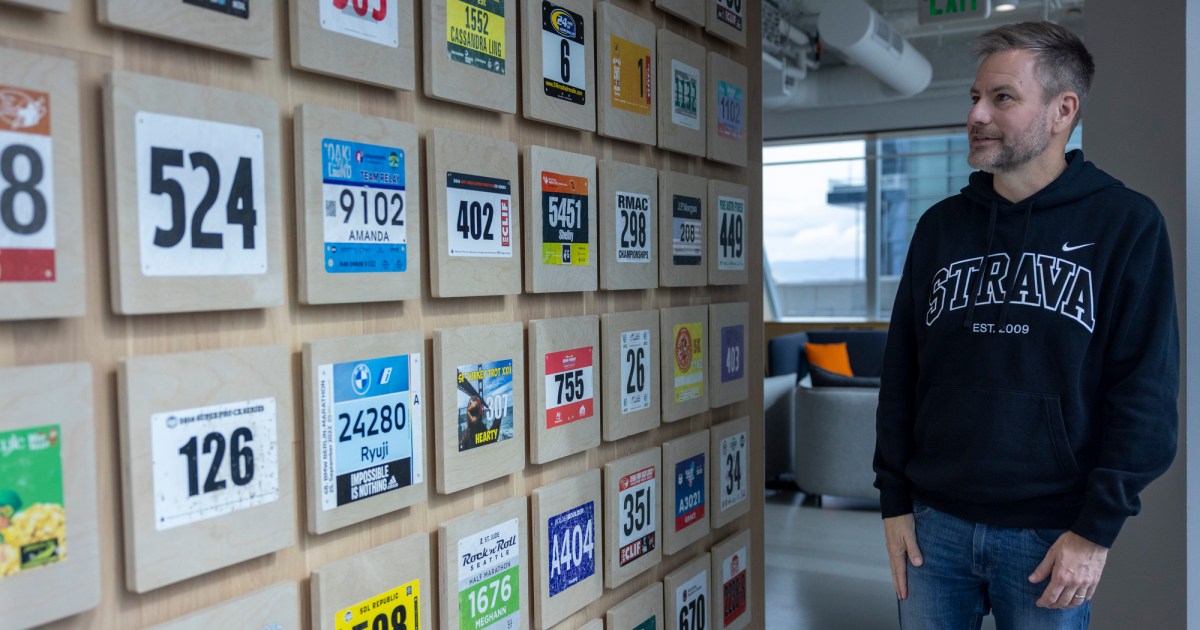
The company’s chief people officer, Michele Bousquet, said the search for a new headquarters started in earnest last spring. After touring more than 20 properties, she said, the company narrowed down the list to five but circled back to 181 Fremont because of its location, safety, and access to amenities like Salesforce Park, which is connected to the building.
“We knew we were going to get good value,” Bousquet said, adding that after three months of touring, Strava was able to quickly negotiate a sublease deal with Meta and move in four months later.
Since 2019, the company’s headcount has grown from 175 to 430, she said. Strava employees are still allowed to work from home but are asked to come in at least two or three days a week. Lunch is catered on Tuesdays and Wednesdays, and the employees have organized a weekly team workout since moving into the building.
San Francisco, CA
San Francisco residents attend Ash Wednesday, pray for Pope Francis

Ash Wednesday marked the beginning of Lent, a period of reflection for Catholics worldwide. While many gathered today to receive ashes, a symbol of faith, worshippers in North Beach also lifted up special prayers for Pope Francis, as he remains hospitalized for respiratory complications.
At St. Peter and St. Paul Catholic Church, Father Lam administered ashes to parishioners, continuing a tradition that has persisted for centuries. The custom signifies repentance as the church prepares for its Easter fast.
“We are asking people to do some penance and do some good works, helping others, so we can all go together and prepare ourselves for Easter,” Father Lam said.
However, this year’s Ash Wednesday has a unique significance. The global Catholic community is especially focused on prayers for the pope, who has spent nearly three weeks in the hospital battling respiratory issues.
“We ask you to pray for his speedy recovery, so that he can resume his duty as the pastor of the whole world,” Father Lam added.
The pope’s illness comes amid concerns over a significant decline in church attendance. A recent 2024 report from the Hartford Archdiocese revealed an 18% drop in Catholic church attendance from 2019 to 2024. This decline has been attributed, in part, to an increasing number of Americans identifying with no religious affiliation.
Despite the trend, some church leaders are optimistic. Frank Lavin, a Eucharist minister, noted a positive shift in attendance at St. Peter and St. Paul.
“It was really great this morning to see so many people in church getting their ashes again. Because it used to be a really big deal to go to church on Ash Wednesday, get ashes, give something up for Lent. So, I feel like the tide is kind of changing,” Lavin said.
The decline in attendance is also linked to ongoing controversies, including the church’s decades-long sexual abuse scandal. Yet, Father Lam remains hopeful about the church’s future.
“When you look at the human face of the church, we find many faults and many defects and so on, but don’t forget that Jesus Christ is the real leader of the church. So we have to look at the church not only from the human point of view, but also from the divine perspective,” Father Lam said.
It is this divine perspective, he believes, that sustains his commitment to serving his community.
San Francisco, CA
Illegal vape hunt: SF launches Bay Area-wide undercover op
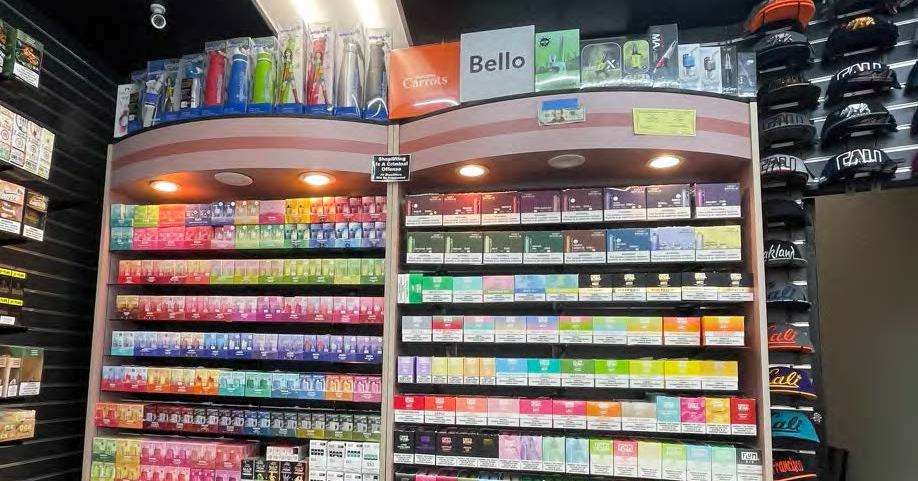
A large-scale undercover operation caught 11 smoke shops selling flavored vapes and other illegal tobacco products, the San Francisco city attorney’s office said Wednesday.
The investigation revealed that two owners were flouting laws restricting e-cigarettes and flavored tobacco products and operating without a permit after health inspectors found vapes and flavored pouches at a Mission Street smoke shop.
The Department of Public Health in March 2024 ordered the owners of Bass Gift Shop at 5196 Mission St. to stop selling tobacco and make the shop accessible to inspectors. The owners sold an illegal vape to a department decoy investigator in May and refused an inspection in June.
Exotic Vapes, 711 Kains Ave., San Bruno
Exotic Puff n Stuff, 484 San Mateo Ave., San Bruno
Grand Tobacco Shop, 338 Grand Ave., South San Francisco
Diamond Gift Shop, 6198 Mission St., Daly City
420 Glass and Gift Shop, 2502 Telegraph Ave., Oakland
Smoke and Gift Shop, 646 Hegenberger Rd, Oakland
Fast Fill Gas and Market, 449 Hegenberger Rd., Oakland
Cigarettes Cheaper!, 20930 Mission Blvd., Hayward
Smoke Shop, 6193 Santa Teresa Blvd., San Jose
Delauers Gift Shop, 1412 Park St., Alameda
A $250,000 judgment, approved Monday by San Francisco Superior Court Judge Barbara Zuniga, requires owners Basserty Alriashi and Muneer Al Osfur to surrender all illegal flavored tobacco products to state or local authorities.
An attorney for Alriashi and Al Osfur did not respond to requests for comment.
Under the settlement, the defendants must prominently display the California Department of Public Health’s fact sheet on the flavored tobacco law and allow inspections by state and local agencies.
Health officials noted that flavored e-cigarettes have threatened progress in reducing youth tobacco use. According to the Public Health Department, 7.9% of San Francisco high school students reported using e-cigarettes in 2021.
Sales of flavored tobacco products have been banned in San Francisco since 2018, when voters approved Proposition E in response to the rising popularity of vaping by youths.
In 2019, the Board of Supervisors unanimously passed a ban on the sales of most e-cigarettes over the protests of Juul Labs, which was then headquartered in San Francisco and a major producer of vapes. A company-sponsored ballot measure that would have reauthorized sales was defeated later that year.
In recent years, the city attorney’s office has also pursued online retailers of flavored products and branded nicotine pouches.
-

 Sports1 week ago
Sports1 week agoNHL trade board 7.0: The 4 Nations break is over, and things are about to get real
-

 News1 week ago
News1 week agoJustice Dept. Takes Broad View of Trump’s Jan. 6 Pardons
-

 World1 week ago
World1 week agoHamas says deal reached with Israel to release more than 600 Palestinians
-

 Science1 week ago
Science1 week agoKilling 166 million birds hasn’t helped poultry farmers stop H5N1. Is there a better way?
-

 News1 week ago
News1 week agoChristianity’s Decline in U.S. Appears to Have Halted, Major Study Shows
-
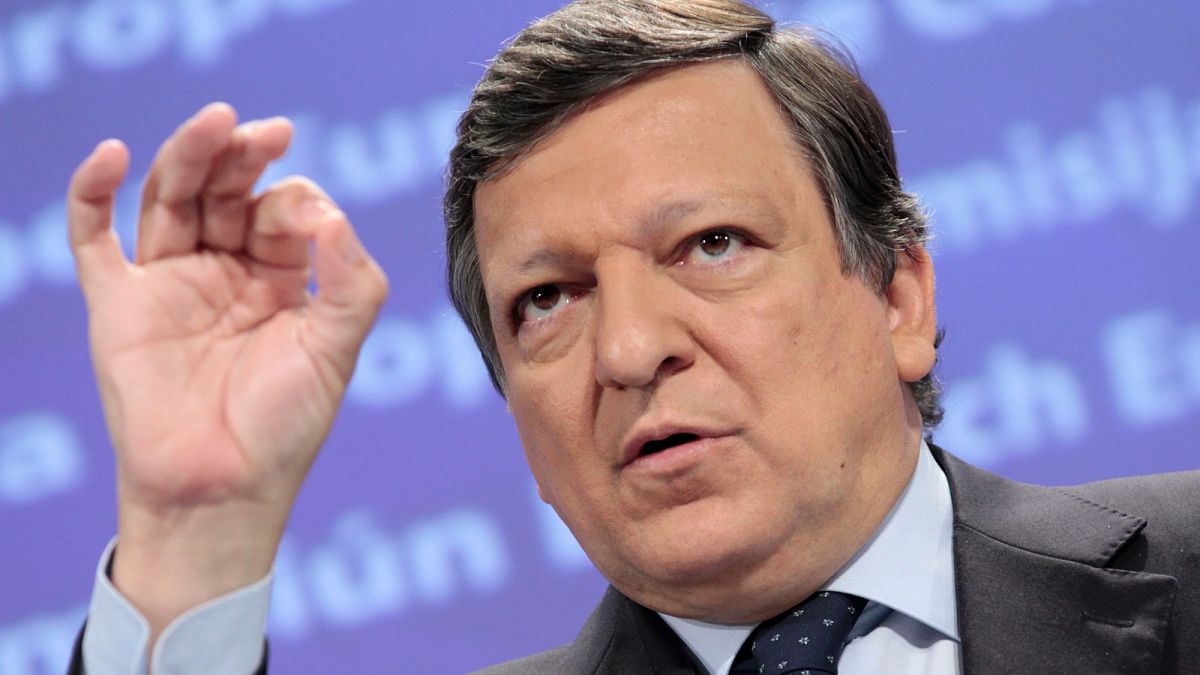
 World1 week ago
World1 week agoGermany's Merz ‘resolute and determined,' former EU chief Barroso says
-

 Technology1 week ago
Technology1 week agoMicrosoft makes Copilot Voice and Think Deeper free with unlimited use
-

 Culture1 week ago
Culture1 week agoOstriches, butt cheeks and relentless energy: How Austin Hedges became an indispensable MLB teammate

